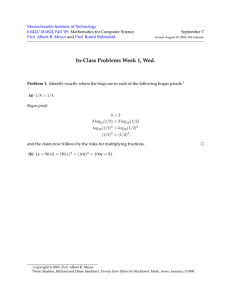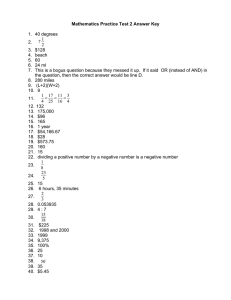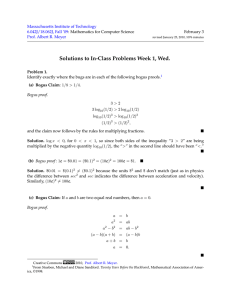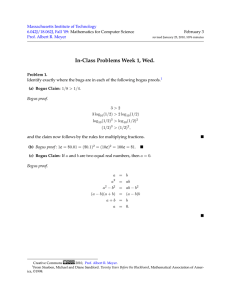: Mathematics for Computer Science September 7 and Massachusetts Institute of Technology
advertisement
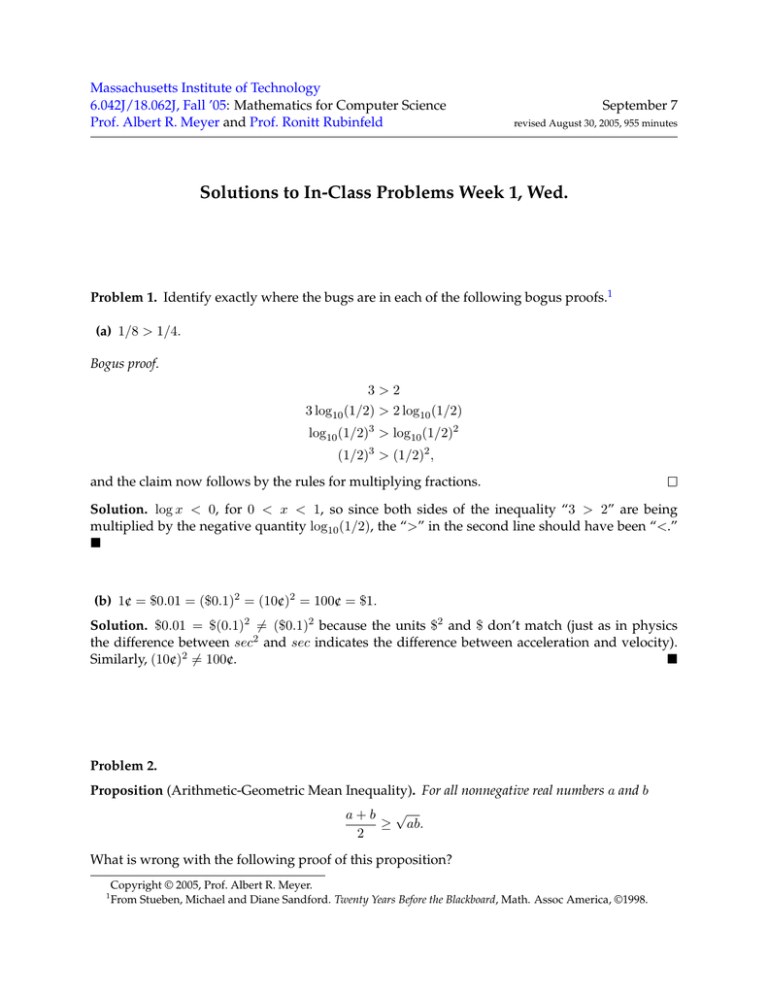
Massachusetts Institute of Technology 6.042J/18.062J, Fall ’05: Mathematics for Computer Science Prof. Albert R. Meyer and Prof. Ronitt Rubinfeld September 7 revised August 30, 2005, 955 minutes Solutions to In­Class Problems Week 1, Wed. Problem 1. Identify exactly where the bugs are in each of the following bogus proofs.1 (a) 1/8 > 1/4. Bogus proof. 3>2 3 log10 (1/2) > 2 log10 (1/2) log10 (1/2)3 > log10 (1/2)2 (1/2)3 > (1/2)2 , and the claim now follows by the rules for multiplying fractions. Solution. log x < 0, for 0 < x < 1, so since both sides of the inequality “3 > 2” are being multiplied by the negative quantity log10 (1/2), the “>” in the second line should have been “<.” � (b) 1¢ = $0.01 = ($0.1)2 = (10¢)2 = 100¢ = $1. Solution. $0.01 = $(0.1)2 = � ($0.1)2 because the units $2 and $ don’t match (just as in physics 2 the difference between sec and sec indicates the difference between acceleration and velocity). Similarly, (10¢)2 �= 100¢. � Problem 2. Proposition (Arithmetic­Geometric Mean Inequality). For all nonnegative real numbers a and b a+b √ ≥ ab. 2 What is wrong with the following proof of this proposition? 1 Copyright © 2005, Prof. Albert R. Meyer. From Stueben, Michael and Diane Sandford. Twenty Years Before the Blackboard, Math. Assoc America, ©1998. 2 Solutions to In­Class Problems Week 1, Wed. Bogus proof. a+b ? √ ≥ ab 2 ? √ a + b ≥ 2 ab ? a2 + 2ab + b2 ≥ 4ab ? a2 − 2ab + b2 ≥ 0 (a − b)2 ≥ 0 The last statement is true because a − b is a real number, and the square of a real number is never negative. This proves the claim. Solution. In this argument, we started with what we wanted to prove and then reasoned until we reached a statement that is surely true. The little question marks presumably are supposed to indicate that we’re not quite certain that the inequalities are valid until we get down to the last step. At that step, the out, but that doesn’t prove the claim. All we have proved is √ inequality checks 2 that if (a + b)/2 ≥ ab, then (a − b) ≥ 0, which is not very interesting, since we already knew that the square of any nonnegative number is nonnegative. To be fair, this bogus proof is pretty good: if it was written in reverse order – or if “is implied by” was simply inserted after each line – it would actually prove the Arithmetic­Geometric Mean Inequality: Proof. a+b √ ≥ ab 2 √ a + b ≥ 2 ab, is implied by which is implied by 2 2 which is implied by 2 2 which is implied by a + 2ab + b ≥ 4ab, a − 2ab + b ≥ 0, 2 (a − b) ≥ 0. The last statement is true because a − b is a real number, and the square of a real number is never negative. This proves the claim. But the problem with the bogus proof as written is that it reasons backward, beginning with the proposition in question and reasoning to a true conclusion. This kind of backward reasoning can easily “prove” false statements. Here’s an example: False Claim. 0 = 1. Solutions to In­Class Problems Week 1, Wed. 3 Bogus proof. ? 0=1 ? 1=0 ? 0+1=1+0 1=1 and the last equality is trivially true. We can also come up with very easy “proofs” of true theorems, for example, here’s an easy “proof” of the Arithmetic­Geometric Mean Inequality: Bogus proof. a+b ? √ ≥ ab 2 √ a+b ? 0· ≥ 0 · ab 2 0≥0 So watch out for backward proofs! �
